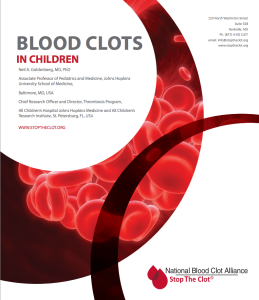How are DVT/PE diagnosed in children?
Definitions:
- Scan: A way to take images (similar to pictures) of something inside the body, such as a blood clot.
- Ultrasound: A type of scan that uses a wand and sound waves to create an image of the veins blood flow through the veins. on a computer. At times during the procedure, the wand is pressed down gently on the area of the body that is located on top of the vein. The image shows blood flow through the veins.
- Computed tomography (CT) venogram: A type of “CAT” (or CT) scan of veins that is done after we inject dye through an IV. This scan gives us images of the veins and blood flow, and can be useful in areas that are difficult to image by ultrasound.
- IV: A small flexible tube placed in a vein, usually on the inside of the elbow.
- Magnetic resonance (MR) venogram: A type of magnetic resonance imaging (MRI) scan that gives us images of the veins and blood flow. This scan can be useful in areas that are difficult to image by ultrasound.
- CT pulmonary angiogram: A type of scan that uses dye injected through an IV to take images of blood flow in the lung vessels. This scan is often used to diagnose a PE.
- Ventilation-perfusion (V/Q) scan: A type of scan that measures airflow and blood flow throughout the lungs.
Doctors rely on scans to diagnose DVT/PE in children.
- If a DVT is suspected in an arm or leg, an ultrasound is usually done.
- If a DVT is suspected in another part of a child’s body other than the lungs, an ultrasound may be done or a different type of scan may be needed, such as a computed tomography (CT) venogram or magnetic resonance (MR) venogram. A catheter procedure with dye, called a conventional venogram, may be needed when abnormalities of the veins are suspected, such: as May-Thurner syndrome, a narrowing of the left iliac vein where it is crossed by the right iliac artery); Paget-Schroetter syndrome (also called venous thoracic outlet syndrome, or vTOS), a narrowing of the subclavian vein in the area where the collar bone comes in contact with the first rib with repetitive arm movement.
- If a PE is suspected, a CT pulmonary angiogram is often used; sometimes, a ventilation-perfusion (V/Q) scan is done first.
Neil A. Goldenberg, MD, PhD
Professor of Pediatrics and Medicine, Johns Hopkins University School of Medicine,
Baltimore, MD, USA
Founding Director, Pediatric Thrombosis & Stroke Programs
Johns Hopkins All Children’s Hospital
St. Petersburg, FL, USA
Updated: September 2024





